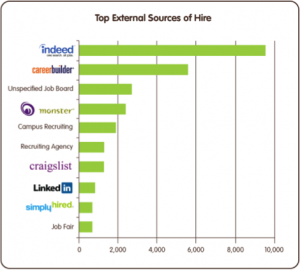Every single time I write about sources of hire, a little red siren goes off in my head with a robotic voice saying, “WARNING: Actual results may vary!” At first glance, the latest from the CareerXroads calls into doubt the effectiveness of social recruiting. Only 3.5% of external hires come from social media? Social recruiting advocates must be wasting their time, right?
That’s where that little red siren starts going off.
Instead of trying to simplistically deduce which source is better or worse than the next and making declarations about the health of job boards, social media or anything else, maybe it is time to think about using all of the available data about how people come to see our jobs and use it to our full advantage?
1. A single source of hire is a rarity
I started my recruiting career before social media and before recruiting via the internet was as huge as it is today. I hand dialed hundreds of applicants to see where they heard about our jobs, both primary and secondary sources. For the people we hired, we also interviewed them and learned of all of the places they saw information about us hiring.
It was messy then, even with fewer possible sources.
At the very beginning of their presentation for the sources of hire survey, CareerXroads stated plainly: “No one source is mutually exclusive. A cross-section of any ‘channel’ will surface several influences.”
Take it from the experts: there are always multiple sources. But more on that in a second. Let’s talk about tracking.
2. Tracking source of hire is difficult

About two-thirds of those surveyed by CareerXroads still relied on self-reported source of hire as at least part of how they came up with their top sources for hire. Many seemed to use other methods as well but it was still the most broadly used tool to identify that source.
Memories are fallible and self-reported data often means another checkbox on a long list of checkboxes that employees fill out their first day (or in the application process). It’s just another part of a form that gets in between them and a new job. But if that’s all you have, you do the best you can with it.
A better way of data collection is to make it as invisible as possible to the candidate. For example, this week, Silkroad released aggregate source of hire data from their OpenHire clients (see: figure above). Again, it is easy to draw conclusions from this simple graph. Job boards take a vast share of the credit for the external hires based on this. But even this process, nearly invisible to the candidate, doesn’t tell the whole story.
3. If there are multiple sources, which source should get credit?

Doug Berg from Jobs2Web had an enlightening presentation at the Recruiting Innovation Summit in Fall of 2011 (Editor’s note: the Recruiting Innovation Summit is run by SourceCon’s parent company, ERE Media). While telling the crowd about how difficult it was to determine source of hire, he shared this slide (see: figure to the right).
An actual candidate had gone through this process to eventually be hired by this company. There are 10 possible sources of hire in the process but only one of them is going to take the credit in most surveys. When we later are comparing source of hire, depending on how it is being reported, it could be the first time the person entered the process, the last source they hit before they hired or any one of those in between if you base it on what is self reported.
All of those sources are important but do you consider them all equally? How do you determine where to spend you time and money?
4. Sources of influence

If we go back again to the CareerXroads survey, you’ll see that the biggest source of external hire are referrals. If we accept the fact that there is no mutually exclusive source, then what else influences referrals?
Based on their research, three-quarters are also influenced by the company career site when someone refers them for a job. Social media and job boards also play a large role in influencing referral hires.
And it makes sense. Think about the last time someone told you to check out a job opening at their company? You’ve probably gone to their website and checked out their social media presence. If you flip it around, you probably found out about a job via a career site or job board and then you asked for the referral if you knew someone there.
Referral may be the chief source but there are many factors that are playing a role. Thinking about your own chief sources of hire and then investigate what other factors help influence the success of that program and you’ll start to get a top-to-bottom view of what’s important.
5. Embracing the bigger picture
The reality is, the top source of hire (or last source of hire) is only a small fraction of the overall discussion when it comes to what to consider when you’re looking to fill a position.
For example, do you get better results with some sources for particular roles in your company? I’m 100% sure that’s the case. And when you’re doing searches, you’re probably focusing in on efforts that have the most potential but are you also disregarding some of those other factors of influence? If a certain source only gives you a small fraction of the results of other sources but you also get that impossible to find candidate (or best hire) off it, is it still worth investing time and resources on the off-chance you’ll be successful? And are you considering cost (both time and actual outlay) when considering what works and what doesn’t?
All of that is well beyond the scope of simply looking at a broad source of hire report and drawing conclusions based on the widely reported numbers alone. It is easier, but a more thorough look internally at the sources of hire, those influencing those sources, and the impact on other factors like type of candidate attained and cost incurred are going to give relevant, actionable information.
